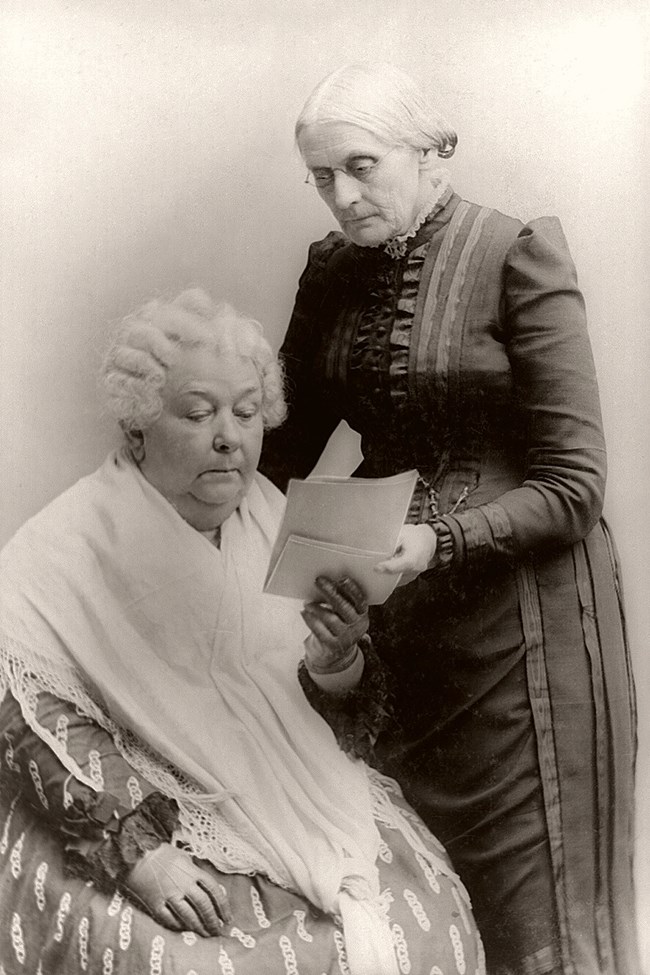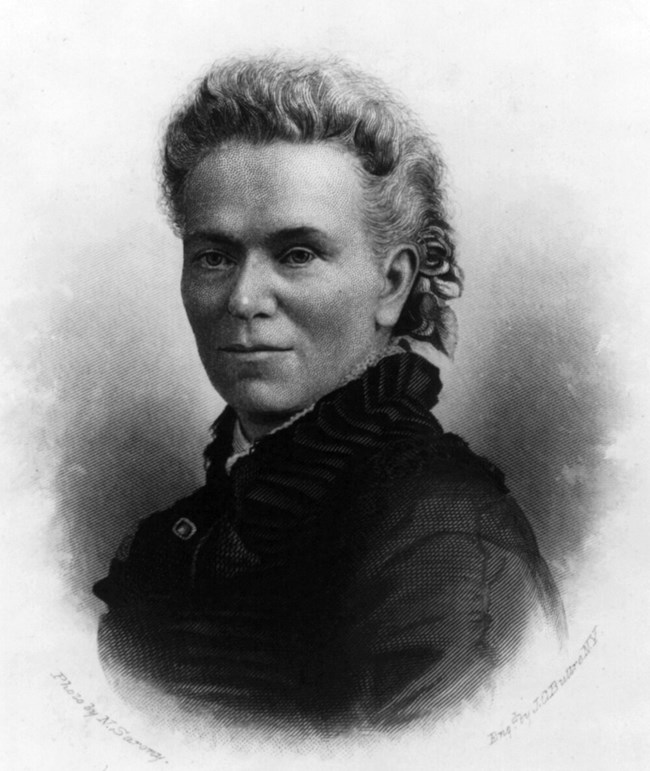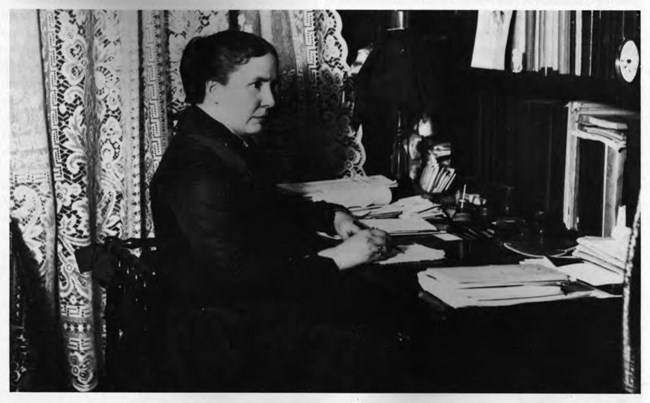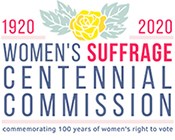Part of a series of articles titled On Their Shoulders: The Radical Stories of Women's Fight for the Vote.
Article
How Native American Women Inspired the Women’s Rights Movement
By Sally Roesch Wagner

Having worked for women’s rights for forty years, Gage and Stanton became increasingly frustrated with their inability to make major gains in their social, economic, or political positions as women by the 1880’s. In their disappointment, they looked beyond the Euro-American culture that was already known intimately to them and gained a vision of a world of equality from their nearby neighbors. Stanton and Gage grew up in the land of the Haudenosaunee, the six nations of the Iroquois Confederacy: the Onondaga, Mohawk, Seneca, Cayuga, Oneida and Tuscarora who had social, religious, economic, and political positions far superior to their own, they wrote.
The Six Nation Haudenosaunee Confederacy had, and still have today, a family/governmental structure based on female authority. Haudenosaunee women controlled the economy in their nations through their responsibilities for growing and distributing the food. They had the final authority over land transfers and decisions about engaging in war. Children came through the mother’s line, not the father’s, and if the parents separated, the children stayed with their mother, and if she died, with her clan family. Women controlled their own property and belongings, as did the children. Political power was shared equally among everyone in the Nation, with decisions made by consensus in this pure democracy, the oldest continuing one in the world.
Still today, the chief and clan mother share leadership responsibilities. The clan mother chooses and advises the chief, placing and holding him in office. These men, appointed by the women, carry out the business of government. The clan mother also has the responsibility of removing a chief who doesn’t listen to the people and make good decisions, giving due consideration to seven generations in the future. To be chosen as a chief, the man cannot be a warrior (since it is a confederacy based on peace), nor can he have ever stolen anything or abused a woman. Women live free of fearing violence from men. The spiritual belief in the sacredness of women and the earth—the mutual creators of life—make rape or beating almost unthinkable. If it occurs, the offender is punished severely by the men of the victim’s clan family – sometimes by death or banishment.

At mid-nineteenth century, the majority of women living in the United States -- that is to say, single and married white women, as well as all enslaved women -- had no say in family or government decisions. It was illegal in every state for women to vote. They could not serve on a jury, sue or be sued, write a will or in any way act as a legal entity. Haudenosaunee women, on the other hand, maintained their own identity and all their rights to their body, property, political voice, and children whether married or unmarried before colonization.
Alice Fletcher, an ethnographer studying Native American cultures and a suffragist, addressed the 1888 International Council of Women, the first United States meeting of women’s rights advocates from throughout the Western world. “Will your husband like to have you give the horse away?” Fletcher recounts asking an Omaha Nation woman she was visiting. This Native American had just given away a “fine quality horse” and, hearing Fletcher’s question, she broke “into a peal of laughter, and she hastened to tell the story to the others gathered in her tent, and I became the target of many merry eyes,” Fletched continued. “Laughter and contempt met my explanation of the white man’s hold upon his wife’s property.”

This model of Native women’s rights gave suffragists the ammunition they needed, and the vision of something better. For years, they had been told by their ministers that the position of women was decreed by God as the eternal punishment women would suffer because of Eve’s sin. Clergy quoted the Bible: “Thy desire shall be to thy husband, and he shall rule over thee" (Genesis 3:16), the command declared all the way through the Bible to the Ephesians, Stanton pointed out. To work for your rights meant going against the will of God. You also were defying biology, since science of the time maintained that women had smaller brains, with less intelligence and physical strength than men. Hence, it was natural that they should be under the authority of men. Seeing Native women who farmed with strong bodies, had total authority over their lives, and lived in equality with men put the lie to religion and science’s teachings of women’s subordination and inferiority.
Gage and Stanton were among the suffragists, like Fletcher, who read about Haudenosaunee women in newspapers and books and also had some personal contact with Native women. They shared what they knew about Native women’s superior rights with other suffragists and the general public. In a series of admiring articles for the New York Evening Post Gage accurately described the Haudenosaunee social and legal structure in which the "division of power between the sexes in this Indian republic was nearly equal" while the family relation "demonstrated woman's superiority in power." “In the home the wife was absolute,” Gage wrote. “If for any cause the Iroquois husband and wife separated, the wife took with her all the property she had brought into the wigwam. The children also accompanied the mother, whose right to them was recognized as supreme.”
Marriage was considered a covenant with God by white, Christian Americans, not a commitment between two people. State laws either outlawed divorce or made it nearly impossible to obtain. Stanton faced criticism from clergy and some other suffragists for promoting divorce in the case of a loveless marriage or one in which the wife was in danger from a violent husband. She celebrated divorce – Haudenosaunee style, pointing to it as a model. “Usually the females ruled the house,” she told the National Council of Women in 1891, and “woe to the luckless husband or lover who was too shiftless to do his share of the providing…he might at any time be ordered to pick up his blanket and budge; and after such an order it would not be healthful for him to attempt to disobey. The house would be too hot for him; and unless saved by the intercession of some aunt or grandmother he must retreat to his own clan, or go and start a new matrimonial alliance in some other.”
Rape and other acts of violence against women by most accounts were rare in Indigenous societies prior to European contact and dealt with harshly in the rare event they occurred. White women who spent time on Native American reservations routinely commented on the degree of safety they felt and the freedom to move at their own will and discretion. A mail carrier in the late 1800’s told a New York Herald reporter visiting the Seneca nation, “A white woman can go around alone among them or on the most desolate roads with perfect safety. I'd rather have my wife or daughter go around alone at night in this reservation than in the town I live in.” A schoolteacher concurred: "It is the only place at which I ever taught in which I never was insulted, . . . I've heard the same from every woman teacher I know on the reservation.”
The suffragists also learned about Haudenosaunee women’s political authority. Stanton told the 1891 National Council of Women that Haudenosaunee women “were the great power among the clan, as everywhere else, . . . The original nomination of the chiefs also always rested with the women,” she told the audience. “They did not hesitate, when occasion required, ‘to knock off the horns,’ as it was technically called, from the head of a chief and send him back to the ranks of the warriors.”
Gage described in her major work, Woman, Church and State, how "The line of descent, feminine, was especially notable in all tribal relations such as the election of Chiefs, and the Council of Matrons, to which all disputed questions were referred for final adjudication.” A well-published and appreciative reporter of the Haudenosaunee social, economic, spiritual, and governmental systems, and supporter of treaty rights and Native sovereignty, Gage was given an honorary adoption into the Wolf Clan of the Mohawk Nation in 1893. She also obtained a clan name: “I received the name of Ka-ron-ien-ha-wi, or 'Sky Carrier,' or as Mrs. Converse said the Senecas would express it 'She who holds the sky.’” Her Mohawk sister said, “this name would admit me to the Council of Matrons, where a vote would be taken, as to my having a voice in the Chieftainship,” Gage wrote. How amazing this must have been to a woman who went to trial the same year for voting in a state school election. Considered for full voting rights in her adopted nation, she was arrested in her own nation for voting.
Indigenous women of numerous Native Nations had rights, sovereignty, and integrity long before European settlers arrived on these shores. They had complete control of their lives, maintained economic independence in marriage, and lived in a culture free from gender-based violence. While women in the United States are recognizing that 100 years ago the Constitution finally recognized the right of U.S. women to vote, Native Nation women have had political voice on this land since the founding of the Iroquois (Haudenosaunee) confederacy over 1000 years ago. And today, the Six Nations clan mothers continue to have the responsibility to nominate, hold in office, and remove their chiefs. Just as our suffrage foremothers before us, non-native women have much to learn from Native women and their centuries of experience.

Author Biography
Awarded one of the first doctorates in the country for work in women’s studies (UC Santa Cruz) and a founder of one the first college-level women’s studies programs in the United States (CSU Sacramento), Dr. Sally Roesch Wagner has taught women’s studies courses for 50 years. She currently serves as an adjunct faculty member in the Syracuse University Renée Crown University Honors Program.
She wrote the faculty guide for Not for Ourselves Alone, Ken Burns’ documentary on Elizabeth Cady Stanton and Susan B. Anthony, and has appeared in that film and numerous history films and radio programs. Dr. Wagner was selected as one of “21 Leaders for the 21st Century” by Women’s E-News in 2015. She serves on the New York Suffrage Centennial Commission.
A prolific author, Dr. Wagner’s anthology The Women's Suffrage Movement, with a Forward by Gloria Steinem (Penguin Classics, 2019), unfolds a new intersectional look at the 19th century women’s rights movement. Sisters in Spirit: Haudenosaunee (Iroquois) Influence on Early American Feminists (Native Voices, 2001) documents the surprisingly unrecognized authority of Native women, who inspired the suffrage movement. It will be followed by her forthcoming young reader’s book, We Want Equal Rights: How Suffragists Were Influenced by Native American Women (Native Voices, August 2020).
Founder and Executive Director of the Matilda Joslyn Gage Center for Social Justice Dialogue in Fayetteville, New York, she received the Katherine Coffey Award for outstanding service to museology from the Mid-Atlantic Association of Museums in 2012.
Bibliography
Blackstone, Sir William. “Chapter XV: Of Husband and Wife,” Commentaries on the Laws of England, Volume I. Oxford: The Clarendon Press, 1765, p. 430.
“Clan Mothers,” Onandoga Nation: People of the Hills, accessed April 15, 2020.
“Family Structure,” Haudenosaune Confederacy, accessed April 15, 2020.
Fletcher, Alice C. “The Legal Condition of Indian Women,” Report of the International Council of Women Assembled by the National Suffrage Association, Washington D.C., March 25 to April 1, 1888. Washington D.C.: Rufus H. Darby, 1888, pp. 237-241.
Gage, Matilda Joslyn. Letter fragment. Woman’s National Liberal Union letterhead [1893]. Matilda Joslyn Gage Papers, Schlesinger Library, Cambridge, MA.
Gage, Matilda Joslyn. "The Remnant of the Five Nations.” The (New York) Evening Post, September 24, 1875.
Gage, Matilda Joslyn. Woman, Church and State: A historical Account of the Status of Woman Through the Christian Ages: With Reminiscences of the Matriarchate. New York: The Truth Seeker Company, p. 13.
Haudenosaune Confederacy, accessed April 15, 2020.
“Historical Life as a Haudenosaune,” Haudenosaune Confederacy, accessed April 15, 2020.
Johnson Lewis, Jone, “The Blackstone Commentaries and Women's Rights,” Thought.Co, February 6, 2019.
“New Perspectives on the West: Alice Fletcher,” PBS.com, accessed April 15, 2020.
"New York's Indians." New York Herald, 2 February N.D., Writings of H. M. Converse and Miscellaneous Scrapbook of Ely S. Parker, p. 105. New York State Archives, Albany, NY.
Poulette, Susanne Marie, “Women’s History Month: The Haudenosaunee and Matilda Joslyn Gage,” Times Union, March 6, 2017.
“Research Guides,” Schlesinger Library on the History of Women in America, accessed April 15, 2020.
Stanton, Elizabeth Cady. “The Matriarchate or Mother-Age,” National Council of Women of the United States. Transactions of the National Council Women of the United States, Assembled in Washington, D.C. February 22 to 25, 1891. Ed. Rachel Foster Avery. Philadelphia, PA: 1891, pp. 218-227.
“Who Was Matilda Joslyn Gage?” The Matilda Joslyn Gage Foundation, accessed April 15, 2020.
Awarded one of the first doctorates in the country for work in women’s studies (UC Santa Cruz) and a founder of one the first college-level women’s studies programs in the United States (CSU Sacramento), Dr. Sally Roesch Wagner has taught women’s studies courses for 50 years. She currently serves as an adjunct faculty member in the Syracuse University Renée Crown University Honors Program.
She wrote the faculty guide for Not for Ourselves Alone, Ken Burns’ documentary on Elizabeth Cady Stanton and Susan B. Anthony, and has appeared in that film and numerous history films and radio programs. Dr. Wagner was selected as one of “21 Leaders for the 21st Century” by Women’s E-News in 2015. She serves on the New York Suffrage Centennial Commission.
A prolific author, Dr. Wagner’s anthology The Women's Suffrage Movement, with a Forward by Gloria Steinem (Penguin Classics, 2019), unfolds a new intersectional look at the 19th century women’s rights movement. Sisters in Spirit: Haudenosaunee (Iroquois) Influence on Early American Feminists (Native Voices, 2001) documents the surprisingly unrecognized authority of Native women, who inspired the suffrage movement. It will be followed by her forthcoming young reader’s book, We Want Equal Rights: How Suffragists Were Influenced by Native American Women (Native Voices, August 2020).
Founder and Executive Director of the Matilda Joslyn Gage Center for Social Justice Dialogue in Fayetteville, New York, she received the Katherine Coffey Award for outstanding service to museology from the Mid-Atlantic Association of Museums in 2012.
Bibliography
Blackstone, Sir William. “Chapter XV: Of Husband and Wife,” Commentaries on the Laws of England, Volume I. Oxford: The Clarendon Press, 1765, p. 430.
“Clan Mothers,” Onandoga Nation: People of the Hills, accessed April 15, 2020.
“Family Structure,” Haudenosaune Confederacy, accessed April 15, 2020.
Fletcher, Alice C. “The Legal Condition of Indian Women,” Report of the International Council of Women Assembled by the National Suffrage Association, Washington D.C., March 25 to April 1, 1888. Washington D.C.: Rufus H. Darby, 1888, pp. 237-241.
Gage, Matilda Joslyn. Letter fragment. Woman’s National Liberal Union letterhead [1893]. Matilda Joslyn Gage Papers, Schlesinger Library, Cambridge, MA.
Gage, Matilda Joslyn. "The Remnant of the Five Nations.” The (New York) Evening Post, September 24, 1875.
Gage, Matilda Joslyn. Woman, Church and State: A historical Account of the Status of Woman Through the Christian Ages: With Reminiscences of the Matriarchate. New York: The Truth Seeker Company, p. 13.
Haudenosaune Confederacy, accessed April 15, 2020.
“Historical Life as a Haudenosaune,” Haudenosaune Confederacy, accessed April 15, 2020.
Johnson Lewis, Jone, “The Blackstone Commentaries and Women's Rights,” Thought.Co, February 6, 2019.
“New Perspectives on the West: Alice Fletcher,” PBS.com, accessed April 15, 2020.
"New York's Indians." New York Herald, 2 February N.D., Writings of H. M. Converse and Miscellaneous Scrapbook of Ely S. Parker, p. 105. New York State Archives, Albany, NY.
Poulette, Susanne Marie, “Women’s History Month: The Haudenosaunee and Matilda Joslyn Gage,” Times Union, March 6, 2017.
“Research Guides,” Schlesinger Library on the History of Women in America, accessed April 15, 2020.
Stanton, Elizabeth Cady. “The Matriarchate or Mother-Age,” National Council of Women of the United States. Transactions of the National Council Women of the United States, Assembled in Washington, D.C. February 22 to 25, 1891. Ed. Rachel Foster Avery. Philadelphia, PA: 1891, pp. 218-227.
“Who Was Matilda Joslyn Gage?” The Matilda Joslyn Gage Foundation, accessed April 15, 2020.
Last updated: December 14, 2020
